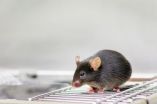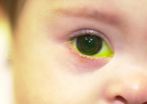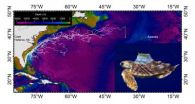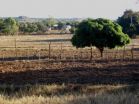(Press-News.org) Flocks of birds manage to navigate through difficult environments by individuals having predispositions to favour the left- or right-hand side, according to research published in PLOS Computational Biology this week.
Scientists at The University of Queensland's Queensland Brain Institute (QBI) and the Australian Research Council Centre of Excellence in Vision Science found that budgerigars display individual bias to fly to the left or right. This allows flocks to quickly navigate past obstacles by being able to split and not slow down due to crowding.
Dr Partha Bhagavatula, the study's first author, says:
"We were looking at finding out how birds decide to navigate, because they're very good at travelling through environments with narrow gaps such as dense bush and forests quickly and without collisions."
Researchers flew the budgerigars down a tunnel where they were met by an obstacle, and a choice of two paths to fly through. Sometimes the paths were of equal size, and sometimes one would be bigger than the other.
"By giving birds the choice of flying left or right, through a pair of two adjacent openings, we were able to see that they displayed individual preferences," Dr Bhagavatula said.
Some birds had no bias and would choose the wider gap every time, while others with a distinct bias preferred going to one side, even if it was significantly narrower than the alternative.
"This is very interesting and unexpected – because it's generally expected for an animal species to have one dominant side that they prefer, so we theorised why this is the case," Dr Bhagavatula commented.
Project leader Professor Mandyam Srinivasan says that more investigations need to be done on this by flying the birds in groups, and seeing how individuals behave in a group dynamic, and whether they maintain those preferences when flying in a flock.
"What's remarkable is that birds display a lateralisation bias in one task, such as route choice, but will have a bias for another task, such as what side they land on a perch, or what leg they favour to land on," Professor Srinivasan said.
"This shows how complex animal thought can be, and essentially we're throwing a spanner in the works with research such as this," he said.
INFORMATION:
Financial disclosure: This research was supported by an ARC Centre of Excellence in Vision Science (Grant CE0561903), ARC Discovery Grant DP 110103277, and by a Queensland Smart State Premier's Fellowship. The funders had no role in study design, data collection and analysis, decision to publish, or preparation of the manuscript.
Competing interests: The authors have declared that no competing interests exist.
Citation: Bhagavatula PS, Claudianos C, Ibbotson MR, Srinivasan MV (2014) Behavioral Lateralization and Optimal Route Choice in Flying Budgerigars. PLoS Comput Biol 10(3): e1003473. doi:10.1371/journal.pcbi.1003473
IN YOUR COVERAGE PLEASE PROVIDE THIS LINK TO THE FREELY AVAILABLE PAPER (the link will go live when the embargo ends): http://www.ploscompbiol.org/article/info:doi/10.1371/journal.pcbi.1003473
CONTACTS:
Mikaeli Costello
Director, Advancement and Communications
Queensland Brain Institute
+61 401 580 685
mikaeli.costello@uq.edu.au;
Professor Mandyam Srinivasan
Queensland Brain Institute
+61 7 3346 6322 or +61 434 603 082
m.srinivasan@uq.edu.au
Birds display lateralization bias when selecting flight paths
2014-03-07
ELSE PRESS RELEASES FROM THIS DATE:
Fighting for survival in the gut: Unravelling the hidden variation of bacteria
2014-03-07
This news release is available in Portuguese.
Our intestines harbour an astronomical number of bacteria, around 100 times the number of cells in our body, known as the gut microbiota. These bacteria belong to thousands of species that co-exist, interact with each other and are key to our health. While it is clear that species imbalances may result in disease, it is unclear at what pace does each species in the gut evolves, a process that contributes to the chance of a particular innocuous species becoming harmful to the host.
In the latest issue of the scientific ...
Contacts better than permanent lenses for babies after cataract surgery
2014-03-06
For adults and children who undergo cataract surgery, implantation of an artificial lens is the standard of care. But a clinical trial suggests that for most infants, surgery followed by the use of contact lenses for several years—and an eventual lens implant—may be the better solution. The trial was funded in part by the National Eye Institute (NEI), a component of the National Institutes of Health.
A cataract is a clouding of the eye's lens, and can be removed through a safe, quick surgical procedure. After cataract removal, most adults and children receive a permanent ...
NASA's Hubble Telescope witnesses asteroid's mysterious disintegration
2014-03-06
NASA's Hubble Space Telescope has recorded the never-before-seen break-up of an asteroid into as many as 10 smaller pieces.
Fragile comets, comprised of ice and dust, have been seen falling apart as they near the sun, but nothing like this has ever before been observed in the asteroid belt.
"This is a rock, and seeing it fall apart before our eyes is pretty amazing," said David Jewitt of the University of California at Los Angeles, who led the astronomical forensics investigation.
The crumbling asteroid, designated P/2013 R3, was first noticed as an unusual, fuzzy-looking ...
Nearby star's icy debris suggests 'shepherd' planet
2014-03-06
VIDEO:
NASA Goddard's Aki Roberge explains how observations with the Atacama Large Millimeter/submillimeter Array in Chile tell us about poison gas, comet swarms and a hypothetical planet around Beta Pictoris....
Click here for more information.
An international team of astronomers exploring the disk of gas and dust around a nearby star have uncovered a compact cloud of poisonous gas formed by ongoing rapid-fire collisions among a swarm of icy, comet-like bodies. The researchers ...
Study provides new information about the sea turtle 'lost years'
2014-03-06
MIAMI – A new study satellite tracked 17 young loggerhead turtles in the Atlantic Ocean to better understand sea turtle nursery grounds and early habitat use during the 'lost years.' The study, conducted by a collaborative research team, including scientists from the University of Miami (UM) Rosenstiel School of Marine and Atmospheric Science, was the first long-term satellite tracking study of young turtles at sea.
"This is the first time we were able to show the maiden voyage of young turtles after they left the beach," said Rosenstiel School scientist Jiangang Luo ...
$4M grant to improve asthma care for So Cal Latino youth
2014-03-06
SAN DIEGO, Calif. (March 6, 2014)—A team led by researchers at San Diego State University has been awarded $4 million to enhance asthma education and treatment strategies in California's Imperial Valley, where children are twice as likely as the national average to suffer from asthma.
The grant will allow researchers to better understand the specific asthma needs of Imperial Valley's largely Latino/Latina population, as well as develop more effective approaches to treatment for families, communities, and physicians.
Approximately 4.5 million African-Americans and 3.6 ...
Fertilizer in small doses yields higher returns for less money
2014-03-06
URBANA, Ill. - Crop yields in the fragile semi-arid areas of Zimbabwe have been declining over time due to a decline in soil fertility resulting from mono-cropping, lack of fertilizer, and other factors. In collaboration with the International Crops Research Institute for the Semi-Arid Tropics (ICRISAT), University of Illinois researchers evaluated the use of a precision farming technique called "microdosing," its effect on food security, and its ability to improve yield at a low cost to farmers.
"Microdosing involves applying a small, affordable amount of fertilizer ...
Story Tips from the Department of Energy's Oak Ridge National Laboratory, March 2014
2014-03-06
MATERIALS – Lighter, stronger engines . . .
Engines could become lighter and more efficient because of a research project that combines the talents and resources of the Chrysler Group, Nemak S.A. of Mexico and Oak Ridge National Laboratory. The goal of the four-year $5.5 million cooperative research and development agreement is to develop an advanced cast aluminum alloy for next-generation higher efficiency engines. In addition to being lighter, the new alloy for cylinder heads would be stronger and capable of sustaining the higher temperatures and pressures of engines ...
Preschoolers can outsmart college students at figuring out gizmos
2014-03-06
Preschoolers can be smarter than college students at figuring out how unusual toys and gadgets work because they're more flexible and less biased than adults in their ideas about cause and effect, according to new research from the University of California, Berkeley, and the University of Edinburgh.
The findings suggest that technology and innovation can benefit from the exploratory learning and probabilistic reasoning skills that come naturally to young children, many of whom are learning to use smartphones even before they can tie their shoelaces. The findings also ...
Kawasaki disease and pregnant women
2014-03-06
In the first study of its type, researchers at the University of California, San Diego School of Medicine have looked at the health threat to pregnant women with a history of Kawasaki disease (KD), concluding that the risks are low with informed management and care.
The findings are published in the March 6, 2014 online edition of the British Journal of Obstetrics and Gynaecology.
KD is a childhood condition affecting the coronary arteries. It is the most common cause of acquired heart disease in children. First recognized in Japan following World War II, KD diagnoses ...





